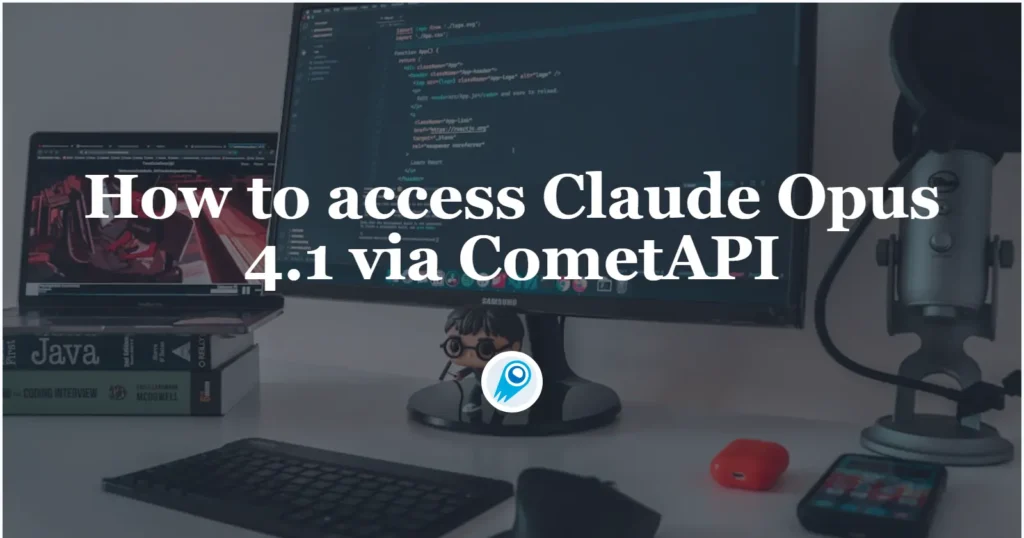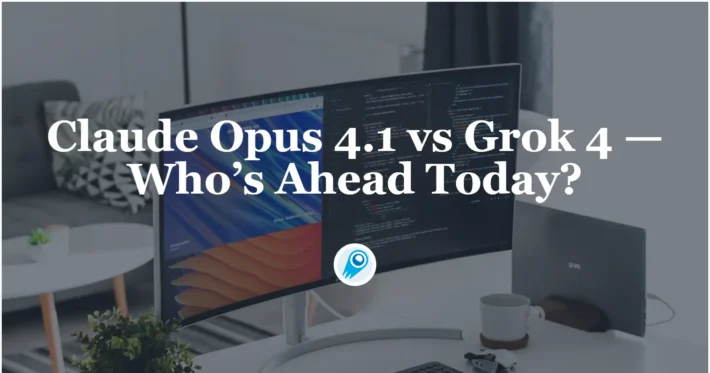How to access Claude Opus 4.1 via CometAPI — a practical, up-to-date guide

Anthropic’s Claude Opus 4.1 arrived as an incremental but meaningful upgrade to the Opus family, with notable gains in coding, agentic workflows, and long-context reasoning. CometAPI—a vendor that aggregates 500+ models behind a single, OpenAI-style API—now exposes Opus 4.1 so teams can call the model without direct Anthropic integration. This article walks you step-by-step through practical access patterns, code examples, configuration tips, cost and safety considerations, and recommended production practices for integrating Opus 4.1 through CometAPI.
What is Claude Opus 4.1 and why is it significant?
Claude Opus 4.1 represents an incremental yet impactful update to Anthropic’s flagship Opus 4 series. Officially released on August 5, 2025, it delivers enhanced precision in multi-step reasoning, agentic workflows, and real-world software engineering tasks . With a 200,000-token context window and optional “thinking” variants supporting up to 64K reasoning tokens, Opus 4.1 pushes the boundaries of AI-assisted coding and autonomous task execution .
Origins and development
Anthropic first introduced the Sonnet series in early 2025, culminating in Opus 4’s May release. Opus 4.1 builds upon this foundation by fine-tuning error-tracking mechanisms and hybrid reasoning layers to reduce hallucinations and streamline multi-phase workflows . Internal benchmarks report a one-standard-deviation improvement on junior developer tasks compared to Opus 4, mirroring leaps seen in earlier Sonnet upgrades.
Key enhancements over Opus 4
- Coding Accuracy: Swe-bench Verified scores rose from 72.5% to 74.5%, with Rakuten teams praising precise multi-file refactorings without extraneous edits.
- Agentic Reasoning: Enhanced tool-calling interfaces drive more reliable autonomous search and decision trees, enabling complex workflow orchestrations.
- Extended Context: Maintains the 200K-token window while “thinking” versions support deep dives up to 64K reasoning tokens, ideal for research and data analysis tasks.
How can developers access Opus 4.1 through CometAPI?
Overview of the integration pathway
CometAPI offers “one API” access to 500+ models and documents an OpenAI-compatible interface that you can call with a CometAPI API key and a base URL override; this makes switching from a direct OpenAI client easy. For Claude Opus 4.1, CometAPI exposes specific model identifiers (for example claude-opus-4-1-20250805 and a thinking variant) and a dedicated chat completions endpoint. The vendor supplies a preconfigured endpoint and example code you can adapt.
Step-by-step quick start
- Register for CometAPI and retrieve your API key from the dashboard (keys are
sk-...style). - Choose the model string: use
claude-opus-4-1-20250805for the standard edition orclaude-opus-4-1-20250805-thinkingif you need the extended “thinking” behavior. CometAPI also documents internal model aliases when applicable. - Set the base URL: point your client to
https://api.cometapi.com/v1(CometAPI supports OpenAI-style payloads). - Craft the request using the OpenAI chat completions format (messages array, system/user roles, etc.).
- Send and process the response; the response shape is OpenAI-compatible so existing parsing logic often works unchanged.
Minimal curl example
bashcurl https://api.cometapi.com/v1/chat/completions \
-H "Authorization: Bearer sk-YOUR_COMETAPI_KEY" \
-H "Content-Type: application/json" \
-d '{
"model": "claude-opus-4-1-20250805",
"messages": [
{"role": "system", "content": "You are a helpful assistant."},
{"role": "user", "content": "Explain how token windows affect long document summarization."}
],
"max_tokens_to_sample": 800,
"temperature": 0.2
}'
This will return a JSON response containing one or more choices; the assistant text is available in choices[0].message.content. The endpoint and parameter names follow the CometAPI docs.
Python (OpenAI client pattern with base_url override)
If you already use an OpenAI SDK or compatible client, you can point it at CometAPI by changing the base URL:
pythonfrom openai import OpenAI
client = OpenAI(
api_key="sk-YOUR_COMETAPI_KEY",
base_url="https://api.cometapi.com/v1"
)
resp = client.chat.completions.create(
model="claude-opus-4-1-20250805",
messages=[
{"role": "system", "content": "You are a senior software architect."},
{"role": "user", "content": "Generate a 200-line high-level test plan for a microservices platform."}
],
max_tokens_to_sample=1200,
temperature=0.1
)
print(resp.choices[0].message.content)
CometAPI’s docs explicitly recommend this OpenAI-style approach and include example snippets for several languages.
Specific CometAPI model endpoints
CometAPI exposes both standard and thinking variants of Opus 4.1, including Cursor-optimized models:
- Standard:
cometapi-opus-4-1-20250805 - Thinking:
cometapi-opus-4-1-20250805-thinking
Use the same chat completions endpoint:
`python from openai import OpenAI
client = OpenAI(base_url="https://api.cometapi.com/v1",
api_key="<YOUR_API_KEY>")
response = client.chat.completions.create( model="cometapi-opus-4-1-20250805", messages=[...], ) :contentReference[oaicite:10]{index=10}.How do you invoke advanced “thinking” capabilities?
Claude Opus 4.1 offers a “thinking” variant (claude-opus-4-1-thinking) that leverages an extended reasoning layer. To access:
response = client.chat.completions.create(
model="claude-opus-4-1-thinking",
messages=[...],
thinking_budget=10000, # budget in reasoning tokens
)This triggers deeper multi-step analysis, ideal for research or agentic tasks .
Pricing
CometAPI offers a discount over Anthropic’s direct pricing: ≈ $12 per million input tokens and $60 per million output tokens, versus the official $15/$75 in Anthropic’s API .
Meanwhile, Anthropic charges:
- $15 per million input tokens
- $75 per million output tokens, with savings via caching and batch processing possible
Use Claude Code via a Proxy (Claude Code Proxy or claudex)
Claude Code is Anthropic’s tool that speaks the Claude API style. By default, it only connects to Anthropic endpoints. But there are open‑source proxy tools that let you redirect Claude Code to work over CometAPI.
Claude Code Proxy: Set up a local proxy that forwards Claude-style requests to a CometAPI endpoint.Example:
OPENAI_API_KEY="your-CometAPI-api-key"
OPENAI_BASE_URL="https://api.cometapi.com/"
BIG_MODEL="anthropic/claude-opus-4-1"Now you can use Claude Code with CometAPI, including the Opus 4.1 model.
See Also How to Install and Run Claude Code via CometAPI?
Which Option to Choose?
| Method | Best For |
|---|---|
| Direct CometAPI API | Simple integration in your own code. |
| Claude Code via Proxy | If you prefer Anthropic’s claude CLI/tooling but want to redirect it to CometAPI. |
What are the best practices for using Opus 4.1 in production?
Maximizing value from Opus 4.1 involves strategic cost management and adherence to safety protocols.
Cost optimization strategies
- Prompt Caching: Cache common assistant responses to reduce repeated compute costs, potentially saving up to 90% on input tokens.
- Batch Processing: Bundle multiple prompts in a single request for bulk operations (e.g., code linting across files).
- Model Selection: Leverage the thinking variant only when extended reasoning is needed; default to standard for simpler tasks.
Ensuring safety and compliance
Under Anthropic’s Responsible Scaling Policy (RSP), Opus 4.1 operates at AI Safety Level 3, featuring anti-jailbreak classifiers, security audits, and a vulnerability bounty program. Maintain compliance by reviewing the model card and system-card addendum for single-turn safety metrics and bias evaluations .
How do I control cost and latency?
- Choose the right model variant. Use Sonnet or cheaper alternatives when you don’t need Opus-level capability. CometAPI’s menu helps you swap models without rewriting code.
- Set appropriate
max_tokensandtemperatureto control output size and cost. - Cache deterministic results (e.g., short utility routines) rather than re-calling the API repeatedly.
How should I design prompts and system messages ?
What role does “system” and “assistant” messaging play?
Opus 4.1 benefits from explicit system instructions that define role, constraints, style, and safety guardrails (e.g., “You are a conservative code reviewer who prioritizes readability and testability”). Use short, actionable system prompts and then decompose tasks into smaller user messages when doing long or multi-stage work.
How to structure multi-step / agentic workflows
- Plan stage — ask Opus to outline steps before executing (this leverages its multi-step strength).
- Run stage — call for concrete code or action using the plan as context.
- Verify stage — ask for tests, edge cases, and a brief self-audit.
Because Opus 4.1 was tuned for “agentic” tasks, explicitly asking the model to “think step-by-step” or to provide a short plan before generating code can significantly improve correctness on complex jobs. (But avoid asking for raw chain-of-thought outputs when you don’t want the model to reveal internal deliberations — Anthropic’s tooling offers “thinking summaries” as a safer alternative in some contexts.)
Getting Started
CometAPI is a unified API platform that aggregates over 500 AI models from leading providers—such as OpenAI’s GPT series, Google’s Gemini, Anthropic’s Claude, Midjourney, Suno, and more—into a single, developer-friendly interface. By offering consistent authentication, request formatting, and response handling, CometAPI dramatically simplifies the integration of AI capabilities into your applications. Whether you’re building chatbots, image generators, music composers, or data‐driven analytics pipelines, CometAPI lets you iterate faster, control costs, and remain vendor-agnostic—all while tapping into the latest breakthroughs across the AI ecosystem.
Developers can access Claude Opus 4.1 through CometAPI, the latest models version listed are as of the article’s publication date. To begin, explore the model’s capabilities in the Playground and consult the API guide for detailed instructions. Before accessing, please make sure you have logged in to CometAPI and obtained the API key. CometAPI offer a price far lower than the official price to help you integrate.
Conclusion — When to use Opus 4.1 via CometAPI
If you need rapid access to Anthropic’s best Opus 4.1 capabilities without the overhead of managing a direct vendor integration, calling Opus 4.1 through CometAPI is an excellent option: it’s fast to get started, OpenAI-style compatible, and convenient for multi-model experimentation. For very sensitive or contractually demanding applications, evaluate direct cloud partner options as well. Complement automated testing and human review, optimize prompts for token efficiency, and instrument cost and safety signals before scaling. The combined vendor releases and the CometAPI listing make it straightforward to trial Opus 4.1 in your stack today.



